
- 240 pages
- English
- ePUB (mobile friendly)
- Available on iOS & Android
Testing Angular Applications
About this book
Summary Testing Angular Applications is an example-rich, hands-on guide that gives you the real-world techniques you need to thoroughly test all parts of your Angular applications. By the end of this book, you'll be able to confidently write unit and end-to-end tests for Angular applications in TypeScript.Foreword by Brad Green, Google.Purchase of the print book includes a free eBook in PDF, Kindle, and ePub formats from Manning Publications. About the Technology Don't leave the success of your mission-critical Angular apps to chance. Proper testing improves code quality, reduces maintenance costs, and rewards you with happy users. New tools and best practices can streamline and automate all aspects of testing web apps, both in development and in production. This book gets you started. About the Book Testing Angular Applications teaches you how to make testing an essential part of your development and production processes. You'll start by setting up a simple unit testing system as you learn the fundamental practices. Then, you'll fine-tune it as you discover the best tests for Angular components, directives, pipes, services, and routing. Finally, you'll explore end-to-end testing, mastering the Protractor framework, and inserting Angular apps into your continuous integration pipeline. What's inside
- Getting to know TypeScript
- Writing and debugging unit tests
- Writing and debugging end-to-end tests with Protractor
- Building continuous integration for your entire test suite
About the Reader This book is for readers with intermediate JavaScript skills. About the Author Jesse Palmer is a senior engineering manager at Handshake. Corinna Cohn is a single-page web application specialist. Mike Giambalvo and Craig Nishina are engineers at Google. Table of Contents
- Introduction to testing Angular applications
PART 1 - Unit testing
- Creating your first tests
- Testing components
- Testing directives
- Testing pipes
- Testing services
- Testing the router
PART 2 - End-to-end testing
- Getting started with Protractor
- Understanding timeouts
- Advanced Protractor topics
PART 3 - Continuous integration
- Continuous integration
- Appendix A - Setting up the sample project
- Appendix B - Additional resources
Frequently asked questions
- Essential is ideal for learners and professionals who enjoy exploring a wide range of subjects. Access the Essential Library with 800,000+ trusted titles and best-sellers across business, personal growth, and the humanities. Includes unlimited reading time and Standard Read Aloud voice.
- Complete: Perfect for advanced learners and researchers needing full, unrestricted access. Unlock 1.4M+ books across hundreds of subjects, including academic and specialized titles. The Complete Plan also includes advanced features like Premium Read Aloud and Research Assistant.
Please note we cannot support devices running on iOS 13 and Android 7 or earlier. Learn more about using the app.
Information
1
Introduction to testing Angular applications
- Understanding Angular testing
- Getting a first look at TypeScript
- Understanding the basics of unit and end-to-end tests
- Introducing Jasmine, Karma, and Protractor
1.1 Angular testing overview
- Components —Chunks of code that you can use to encapsulate certain functionality that you can then reuse throughout the application. Components are types of directives (see next bullet), except they include a view or HTML template.
- Directives —Used to manipulate elements that exist in the DOM or can add elements to or remove them from the DOM. Examples of directives included with Angular are
ngFor,ngIf, andngShow. - Pipes —Used to transform data. For example, say you want to turn an integer into currency. You would use a currency filter pipe to turn 15 into $15.00.
- Services —Although services technically don’t exist in Angular, the concept is still important. You’ll use services to fetch data and then inject it into your components.
- Routing —Allows users to navigate from one view to the next as they perform tasks in the web application.
Table of contents
- Cover
- Titlepage
- Copyright
- Dedication
- foreword
- preface
- acknowledgments
- about this book
- about the authors
- about the cover illustration
- Chapter 1: Introduction to testing Angular applications
- part 1: Unit testing
- part 2: End-to-end testing
- part 3: Continuous integration
- Appendix A: Setting up the sample project
- Appendix B: Additional resources
- Index
- Lists of Figures, Tables and Listings